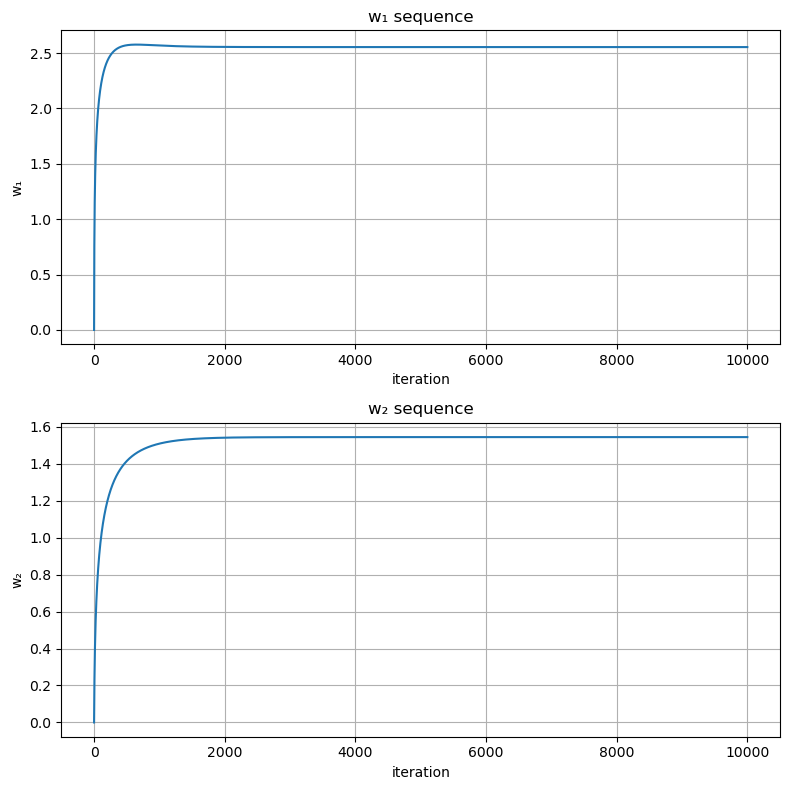1. 勾配を用いる必要性
対数事後分布の勾配を計算するのが今後のアプローチのコアである。
1.2 勾配を用いた計算の効率化
1.2.4 ロジスティック回帰
########################################### ### Laplace近似によるロジスティック回帰 ### ########################################### using Distributions, PyPlot, ForwardDiff, LinearAlgebra # n次元単位行列 eye(n) = Diagonal{Forward64}(I, n) # パラメータ抽出用の関数 unzip(a) = map(x -> getfield(a, x), fieldnames(eltype(a))) # グラフの諸設定を行う関数 function set_options(ax, xlabel, ylabel, title; grid = true, gridy = false, legend = false) ax.set_xlabel(xlabel) ax.set_ylabel(ylabel) ax.set_title(title) if grid if gridy ax.grid(axis = "y") else ax.grid() end end legend && ax.legend() end # 最適化ラッパー関数の定義 function gradient_method(f, x_init, η, maxiter) x_seq = Array{typeof(x_init[1]), 2}(undef,length(x_init), maxiter) g(x) = ForwardDiff.gradient(f, x) x_seq[:, 1] = x_init for i in 2:maxiter x_seq[:, i] = x_seq[:, i-1] + η*g(x_seq[:, i-1]) end x_seq end function inference_wrapper_gd(log_joint, params, w₁_init, η, maxiter) ulp(w₁) = log_joint(w₁, params...) w₁_seq = gradient_method(ulp, w₁_init, η, maxiter) w₁_seq end ### 観測値 X_obs = [-3,1,2] Y_obs = Bool.([0,1,1]) sig(x) = 1/(1 + exp(-x)) # 事前分布の設定 μ₁ = 0 μ₂ = 0 σ₁ = 10.0 σ₂ = 10.0 # 対数同時分布 log_joint(w, X, Y, μ₁, σ₁, μ₂, σ₂) = logpdf(Normal(μ₁,σ₁), w[1]) + logpdf(Normal(μ₂,σ₂), w[2]) + sum(logpdf.(Bernoulli.(sig.(w[1]*X_obs .+ w[2])), Y_obs)) params = (X_obs, Y_obs, μ₁, σ₁, μ₂, σ₂) # 非正規化対数事後分布 ulp(w) = log_joint(w, params...) ### 最適化用パラメータ w_init = [0.0, 0.0] maxiter = 10000 η = 0.1 # 最適化の実施 w_seq = inference_wrapper_gd(log_joint, params, w_init, η, maxiter) # 勾配法の過程を可視化 fig,axes = subplots(2, 1, figsize = (8,8)) axes[1].plot(w_seq[1,:]) set_options(axes[1], "iteration", "w₁", "w₁ sequence") axes[2].plot(w_seq[2,:]) set_options(axes[2], "iteration", "w₂", "w₂ sequence") tight_layout() # 平均 μ_approx = w_seq[:,end] # 共分散 hessian(w) = ForwardDiff.hessian(ulp, w) Σ_approx = inv(-hessian(μ_approx)) w₁s = range(-10, 30, length = 1000) w₂s = range(-20, 20, length = 1000) fig, axes = subplots(1, 2, figsize = (8,4)) cs = axes[1].contour(w₁s, w₂s, [exp(ulp([w₁,w₂])) + eps() for w₁ in w₁s, w₂ in w₂s]', cmap = "jet") axes[1].clabel(cs, inline = true) set_options(axes[1], "w₁", "w₂", "unnormalised posterior") cs = axes[2].contour(w₁s, w₂s, [pdf(MvNormal(μ_approx, Σ_approx), [w₁,w₂]) for w₁ in w₁s, w₂ in w₂s]', cmap = "jet") axes[2].clabel(cs, inline = true) set_options(axes[2], "w₁", "w₂", "approximate posterior")


このようにロジスティック回帰では、事後分布が多変量正規分布にならず、近似が上手くいかない。
